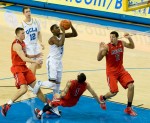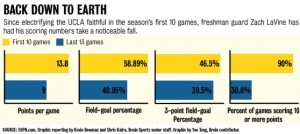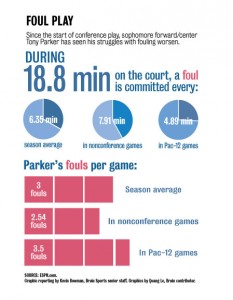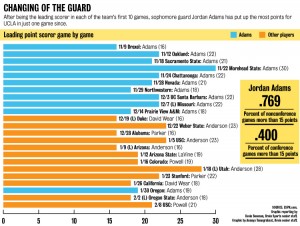Things appeared to be looking up for UCLA men’s basketball.
Three days prior, the Bruins stormed back to earn a last-minute, two-point win over the defending Pac-12 champion Oregon. Two days after that, a Cal buzzer beater toppled first-place Arizona, which lost starting forward Brandon Ashley to a season-ending injury in the game. A win over lowly ranked Oregon State would set the Bruins in sole possession of second place and just one game back of an Arizona team at its most vulnerable.
The rest of the season’s trajectory seemed laid out in front of the Bruins, with prime Pac-12 positioning theirs for the taking. But they let it slip through their fingers.
UCLA’s momentum came to a swift stop with its loss to Oregon State, as the Bruins’ high aspirations were dragged back down into the mob of teams that occupy the middle of the Pac-12 standings. Rather than leading the hunt, UCLA became just another member of the pack.
After an upward trend, UCLA’s season has flatlined, as has the team’s plays on the court. Things have gotten stagnant or regressed in some cases. In the loss to Oregon State and spilling into the first half of Saturday’s game against USC six days later, coach Steve Alford grew frustrated with the absence of energy and passion from his team.
“I thought of all of our games – not just league games – I just thought that was the one game where we didn’t have that ‘it,’ that ‘it’ factor of just really competing like we know we can compete for 40 minutes, and that’s what was frustrating,” Alford said about the loss to Oregon State.
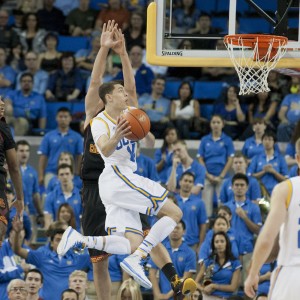
(Katie Meyers/Daily Bruin senior staff)
That same problem has plagued the Bruins throughout the season: the need for the team to maintain its energy throughout the game and play a full 40 minutes. The problem Alford acknowledges has been met with the same response by players.
That was the response after the first game of the season against Drexel, in which UCLA’s defense lagged in the second half. And that was the response three months later as UCLA found themselves trailing by six at halftime against a USC team that sat in last place in the Pac-12.
“Our older guys, our veterans knew we didn’t have so good a half and that’s unacceptable, especially in February, so we just had to make up for it second half,” said sophomore guard/forward Kyle Anderson following the USC game. “We still gotta learn how to put a whole 40 minutes together.”
The issue of consistency is one that has plagued the team all year in terms of energy and has permeated into other parts of the Bruins’ play.
Rebounding had been an area of improvement in recent weeks, but UCLA was out-rebounded in consecutive games by Oregon State and USC teams that are both in the bottom five in rebound margin in the conference.
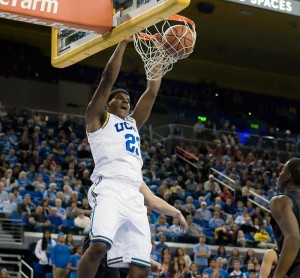
(Tim Bradbury/Daily Bruin senior staff)
Then, the Bruins’ assist-to-turnover ratio, a statistic that has been consistently strong all year, began to nosedive. After committing just six turnovers to its 23 assists in a win over Stanford on Jan. 23, UCLA has steadily declined in that area. The Bruins had more turnovers than assists in two of the next three games, and nearly broke even in the outlier game.
“That’s another thing that we’re good at, that once we put more focus on we can get better at taking care of the ball like we have been all season,” Anderson said. “These last few games have been tough and we’ve been turning the ball over a little bit more, but like I said, we just gotta get to focusing on that and get back to being very good at taking care of the ball.”
The lapses in consistency can be seen on the micro level as well. Sophomore guard Jordan Adams has seen his shooting numbers fluctuate dramatically from game to game in Pac-12 play after scoring 20 or more points in seven of the season’s first nine games.
Freshman guard Zach LaVine was one of the hottest freshmen in the nation to start the year, shooting nearly 60 percent from the field, but his play has tapered off to the point that he has scored in double figures in just four out of the last 13 games.
And sophomore forward/center Tony Parker seems to follow every breakout performance with a dud, most recently with a zero-point, four-foul effort against Cal after scoring a career-high 22 points against Stanford the game before.
Like each of those players, the Bruins have shown spurts of dominance, but haven’t been able to maintain that level of play for an extended period.
But despite three consecutive halves of sloppy play and lackluster effort, and despite nearly a month of growth and setbacks, the Bruins emerged from the locker room Saturday at the Galen Center optimistic after their strong second-half performance against USC.
“First time in a month and a half … we felt like we came out in the second half with a different mindset,” Adams said.
Maintaining that mindset will now be the challenge for the Bruins, who are clinging on to a second-place spot in the Pac-12 with four other teams within just a game of them. UCLA will have to play three out of those four teams in its final eight games and will be looking to ensure its energy finally becomes consistent.
“This is a tough stretch run. … Now it’s just a matter of starting to play our best basketball,” Alford said. “I thought we were getting to that point. We had a minor setback in Corvallis and we gotta get that back quickly.”
